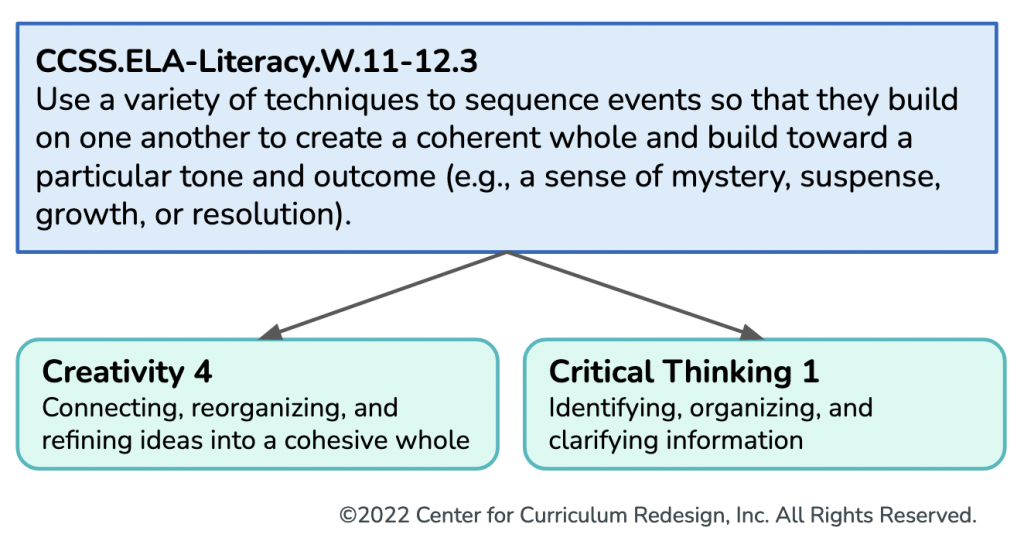January 2, 2023, and July 30, 2024
Creativity, Critical thinking, Communication, and Collaboration (the “4 C’s”) are frequently cited among the skills[1]Sometimes called “Higher-Order Thinking Skills”. For Psychomotor Skills, stay tuned to a new paper in March 2023, and peruse the 2018 version here employers and colleges find desirable, and they’re a hallmark of independent school mission and vision statements and graduate profiles. At the Center for Curriculum Redesign (CCR) and in partnership with the Brookings Institution, we also found these skills showing up in the vision statements of nearly all of the 20+ states, provinces, and countries we deeply studied. Though they’re stated as a priority, none of our studied jurisdictions had mechanisms to help teachers teach them, or to measure student proficiency, unlike content such as literacy or numeracy. What about your school?
As the field lacks deliberate, demonstrable, systematic, comprehensive, and explicit approaches, Independent schools can leverage these novel strategies as a key differentiator.
With our school partners, we work to dispel these notions and partner with teachers in research-backed best practices of high-quality skill instruction. A starting point is the following three-step process:

Step 1: Define the competencies (using sub-competencies)
Because many pernicious and tenacious myths surround these crucial skills, a necessary first step is defining the relevant competencies so everyone can be on the same page with a common language. Let’s take creativity as an example, which often is falsely assumed to be innate, unteachable, or unmeasurable.
Imagining, innovating, wondering, designing—all of these words can get interchangeably jumbled with “creativity.” To ensure learners actually develop proficiency at a competency, we focus on defining these big ideas with the research-identified sub-competencies of CCR’s 4-Dimensional Framework:

This common language enables higher-level conversations between educators. Zeroing in on sub-competencies takes a big idea, like creativity, and distills it into a more manageable chunk. Once these skills are defined, teachers can select the best ones to bring into their classrooms.
Step 2: Select a competency (using the CCR discipline map)
To ensure skills are deliberately targeted, it is necessary to narrow focus with a competency of emphasis. To make these decisions, educators can leverage the CCR recommendations on the best competencies for each discipline. Our team synthesized the body of research literature to identify which competencies frequently show up in each discipline. Then, we paired these “top-down” recommendations from the literature with “bottom-up” validation in a two-round study working with over 70 National State Teacher of the Year Award winners. In disciplinary cohorts, these teachers made their own recommendations for competency/discipline pairings and shared learning experiences in their discipline which leveraged the competency. The published recommendations thus highlight the top four competencies for each discipline, reflecting both the latest research and the insights of educators.
For English Language Arts, for example, creativity, critical thinking, and communication are all identified as top skills to infuse with content (in addition to the competency metacognition). Diving deeper into the learning objectives or standards a curriculum is aligned with can further clarify choices. Take the following eleventh-grade Common Core writing standard, which maps quite cleanly to both a creativity sub-competency and a critical thinking sub-competency:

The key here is that the skills—in this case, creativity and critical thinking—are not divorced from writing standards. Instead, they are infused into the writing process. Learners can simultaneously practice writing and creativity by practicing novel ways to sequence ideas in their own writing. Similarly, they can practice critical thinking through writing by using outlining and mapping exercises to practice logical ordering of information.
In this way, an existing curriculum can be matched to the competencies and sub-competencies that most seamlessly align with it. If a new curriculum is being developed, teachers or curriculum designers can leverage the CCR recommendations as a starting point, and then cross-reference them to the desired standards or learning objectives to identify areas of emphasis.
Step 3: Infuse the sub-competency (which aligns with your learning goals or standards)
With everyone on the same page with how a skill is defined and which parts of the skill are worth focusing on, educators then use these sub-competencies as a basis for developing learning experiences.
For example, although all writing assignments can be argued to be “creative” in some shape or form, a shift in the sub-competency can shift the goal and target:

This infusion process works across all disciplines and competencies—from using critical thinking to complete a geometric proof in mathematics, to communicating the result of an experiment in science, to collaborating with peers in a historical simulation. In all these cases, rigor isn’t sacrificed to teach a “21st Century Skill”[2]http://21stcenturyskillsbook.com/ now superseded by https://curriculumredesign.org/our-work/four-dimensional-21st-century-education-learning-competencies-future-2030/. Standards are accomplished, and extra time is not added to the schedule. Instead, learning is deepened by the competency infusion.
Pairing this instruction with CCR’s patent-pending multi-modal formative assessments allows learners to gather additional evidence on a learner’s competency proficiency. Our Growth Rubrics establish four tiers of proficiency for each sub-competency. A teacher and learner can then review these tiers of proficiency together, identify where the strengths and growth areas are, and chart a path for improvement. Teachers can use them to identify their strengths and growth areas too, as our students learn best from role models of the skill.

Learners then can be proud of portfolios that gather and demonstrate evidence of growth in the 4C’s, setting them up for college, the workforce, and life. It’s a hefty challenge, but a worthwhile one… after all, we’ve still got a few decades left before it’s time to start thinking about 22nd Century Skills!
If you are interested in learning more, complete this interest form. You also can join Robbie Taylor, CCR’s Director of 4D Schools Strategic Planning, for a free 1-hour virtual session on how to teach skills like creativity, critical thinking, communication, and collaboration by RSVPing here. There are 2 time slots for this workshop, January 17 at 3 p.m. EST and January 19 at 12 noon EST, you can select your preference in the form.
For questions about the session or for more information on how a 4-Dimensional Education can enrich your schools, reach out directly to [email protected].
Footnotes
| ↑1 | Sometimes called “Higher-Order Thinking Skills”. For Psychomotor Skills, stay tuned to a new paper in March 2023, and peruse the 2018 version here |
|---|---|
| ↑2 | http://21stcenturyskillsbook.com/ now superseded by https://curriculumredesign.org/our-work/four-dimensional-21st-century-education-learning-competencies-future-2030/ |

